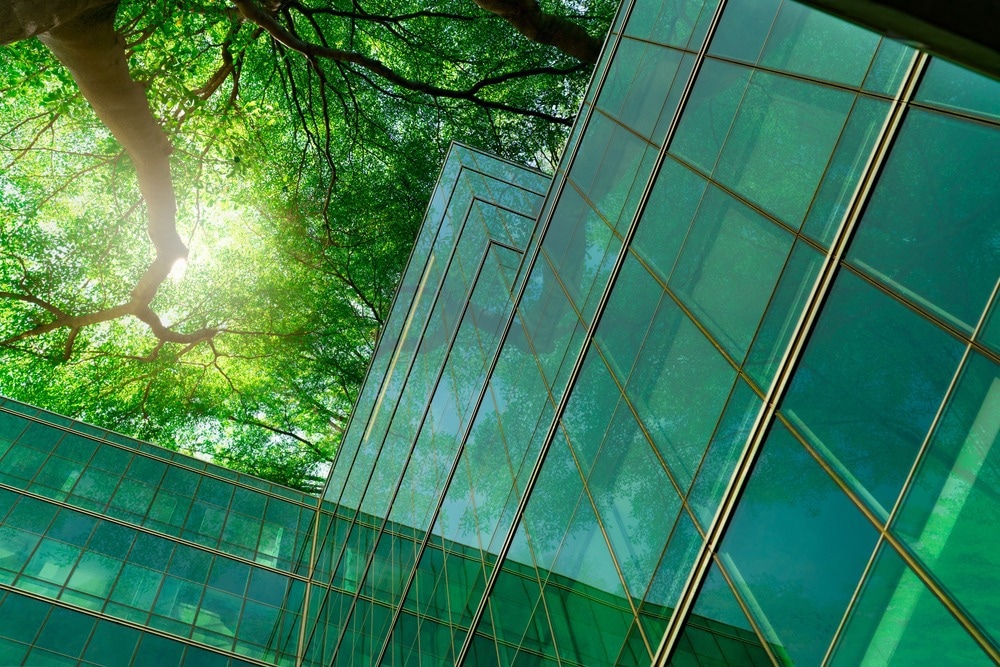Buildings produce as much as 40 percent of all energy-related carbon emissions and waste worldwide. As urbanization continues, emissions from the construction and maintenance of buildings will likely only increase in the near future.

Image Credit: Fahroni/Shutterstock.com
Circular-built environments address this and related challenges by focusing on prevention and regenerative practices. The main goal is to sustain the value of buildings, resources, and products so they can be kept in circulation. Circularity systems focus on long life, resource optimization, upcycling, and recycling. In a circular economy, organizations in the value chain collaborate to eliminate waste, boost resource productivity, use resources responsibly, and increase return material investments.
To standardize ideas, the World Business Council for Sustainable Development (WBCSD) recently published a paper to define metrics for circularity in the building industry.
The paper's authors recommended using consistent terminology to analyze the different layers of a building’s lifecycle. This requires a standardized data collection across the value chain from various stakeholders.
The report authors laid out four key aspects that should be considered when assessing the circularity of buildings:
- Building-related factors, including building owners, organizations behind its construction, location, and construction materials
- The types of data to be collected
- The ways to collect data
- How data should be interpreted
WBCSD officials acknowledged that the new report is only a first step toward standardized measuring of circularity in buildings.
Decision-makers working on building projects could use the report to inform their strategies. However, the WBCSD called for people in the building industry to reach out to the organization and participate in developing a common framework for assessing circularity in buildings.
The circular economy represents the creation of a more sustainable future and significant economic opportunity. This economic approach is a cornerstone in the WBCSD’s vision of 9 billion people living in a fully sustainable society by 2050.
According to the WBCSD, using circularity to reach the UN’s Sustainable Development Goals would mean realizing $3.7 trillion in business opportunities.
Beyond Building: Circularity in Research Science and Retail
The idea of a circular built environment is gaining momentum in the building sector, but the more general concept of holistic sustainability across industries is taking off in other areas as well.
Scientific research is competitive. Different labs and organizations are driven to make the next big breakthrough, and that kind of competition helps push innovations forward. However, the competitiveness of scientific research also creates a protective culture that runs counter to a circular economy. For example, it is common for a lab to hoard supplies or allow them to go bad.
Rheaply is a startup company looking to change that by creating a secondary market for lab supplies. The company can make research cheaper and more efficient by allowing laboratories to sell off supplies they are no longer using.
Rheaply also provides added moral standing to an industry that regularly champions sustainability. An internal study published by University College London found that its laboratory facilities produced half of the school's carbon emissions.
The push for more sustainable practices has driven retailers to lean into this space in the retail industry. Some companies have customers send their gently used products to them for resale, while others provide a platform for their customers to resell their products. According to a recent report from Trove, a company that facilitates branded resale for retailers, more than 120 brands have their own resale channels.
The internet and digital technology have allowed retail to accelerate circularity in new and exciting ways. For example, Patagonia has been looking into QR codes as a way for customers to track specific products throughout their entire life cycle. QR codes also allow retailers to cut back on printed materials.
Scot Case, Vice President of the National Retail Federation, admits that his industry still has a long way to go to develop its own circular economy. However, in a post on the organization’s website, Case said that many retailers are in the midst of a five-, 10-, or 15-year sustainability plan.
The future looks bright for a circular retail economy. Data shows that younger generations are most interested in buying resold products because it allows them better access to designer brands. Case said data also shows that reselling helps retailers build deeper connections with their customers.
References and Further Reading
World Business Council for Sustainable Development (2022) Circular transition indicators: A framework to measure progress. Available at: https://www.wbcsd.org/contentwbc/download/15465/225482/1
Farley, M. (2022) How green is your science? The race to make laboratories sustainable. Nature Reviews Molecular Cell Biology. https://www.nature.com/articles/s41580-022-00505-7
Trove. (2023) Brand Resale Index. https://trove.com/brand-resale-index/
Ralph Lauren (2022) Timeless by Design: Ralph Lauren's commitment to sustainability. Available at: https://corporate.ralphlauren.com/pr_220607_TimelessByDesign.html
Disclaimer: The views expressed here are those of the author expressed in their private capacity and do not necessarily represent the views of AZoM.com Limited T/A AZoNetwork the owner and operator of this website. This disclaimer forms part of the Terms and conditions of use of this website.